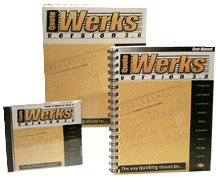QuoteWerks Development Path – A Speculative View
QuoteWerks has long been a staple in the quoting and proposal software space – for IT and managed services providers, plus many, many other product and service provider verticals. Its journey from a classic Windows application to a hybrid web-enabled platform is not just a tale of modernization, it’s a fascinating case study in software evolution. In this article, I’ll explore what I know of QuoteWerks’ development history, its current trajectory, and speculate on what might lie ahead.
Disclaimer: I am not affiliated with the QuoteWerks Development Team, and the insights shared in this article are based purely on my own observations, experience as a developer and reseller, and publicly available information. This is a speculative view intended to explore the possible direction of QuoteWerks’ development path.

Yes - when we first started reselling QuoteWerks, we’d actually package up physical CDs and printed manuals and ship them off to our users.
No cloud, no downloads - just good old-fashioned bubble wrap and stamps!!!
🕰️ From Visual Basic Roots
QuoteWerks began its life in the early 1990s, as I understand it built using Visual Basic 3, later transitioning to VB4. These early versions were tightly coupled to the Windows ecosystem, leveraging native Windows Forms and local databases. At the time, this was a sensible choice – VB was widely used, and Windows was the dominant desktop platform.
As the product matured, integrations with contact management systems and CRMs became more sophisticated. These newer integrations began to use .NET technologies, signalling a shift toward more modular and service-oriented architecture.
🖥️ The Desktop Era
For many years, QuoteWerks Desktop remained the flagship product. It was a robust, locally installed application that offered deep functionality and tight integration with Microsoft Office, Outlook, various contact management packages, and various distributors. Users appreciated its speed, reliability, and offline capabilities.
However, as cloud computing and remote work gained traction, the limitations of a purely desktop-bound application became become more apparent.
🌐 Enter QuoteWerks Web
To address the growing demand for mobility and cross-platform access, QuoteWerks Web was introduced. Built using modern web technologies (most notably ASP.NET, .NET Core and AngularJS) the web version aimed to replicate the Desktop experience in a browser. Over time, feature parity between the two platforms has improved significantly.
QuoteWerks Web offers:
- Browser-based access from any device
- Real-time collaboration
- Seamless CRM and distributor integrations
- A modern UI built on web standards
🔄 The Hybrid Shift: WebView2 in Desktop
In recent years, a subtle but important change has emerged: QuoteWerks Desktop is increasingly featuring screens built with WebView2. WebView2 is a Microsoft control that allows developers to embed Chromium-based web content inside Windows applications.
This move suggests a strategic convergence:
- UI components from the Web version are being reused in the Desktop version.
- Development paths are being unified, allowing for faster updates and consistent user experiences.
- Legacy VB screens are being replaced, incrementally and quietly.
This hybrid approach allows QuoteWerks to modernize without a full rewrite, leveraging the strengths of both platforms.
🧠 Speculation: A Replacement by Stealth?
Given this trajectory, is it reasonable to speculate that QuoteWerks Desktop may be gradually replaced “by stealth”? After all:
- WebView2 enables a slow migration of screens from native to web-based.
- The underlying logic and UI are increasingly shared with the Web version.
- Eventually, the Desktop version could become a thin shell around web components, or perhaps be phased out entirely.
This strategy aligns with the strangler pattern in software architecture: gradually replacing legacy systems with modern components until the old system is no longer needed.
🧭 Conclusion
QuoteWerks’ development path seems to reflect a thoughtful, incremental modernization strategy. From its VB roots to its ASP.NET / AngularJS-powered web platform, and now to a hybrid Desktop / WebView2 model, the product is evolving to meet the needs of modern users.
Whether this leads to a full transition to QuoteWerks Web or a long-term hybrid model remains to be seen. But one thing is clear: the development team is laying the groundwork for a more unified, flexible future.
It’s an exciting time to be part of the QuoteWerks Partner ecosystem. I look forward to seeing how we can continue to enhance the user experience, both within QuoteWerks itself and across the integrated systems that surround it.
 Chat with Us
Chat with Us PREV
PREV